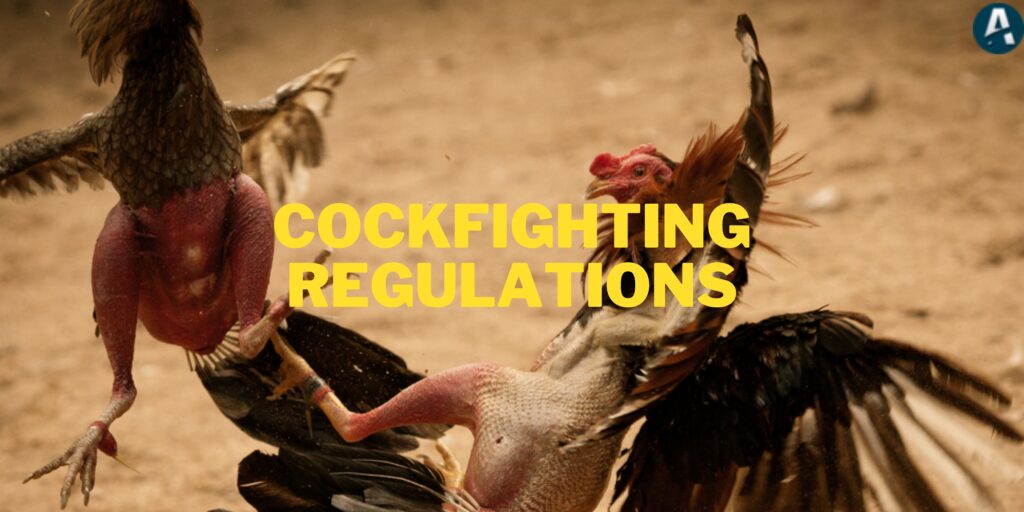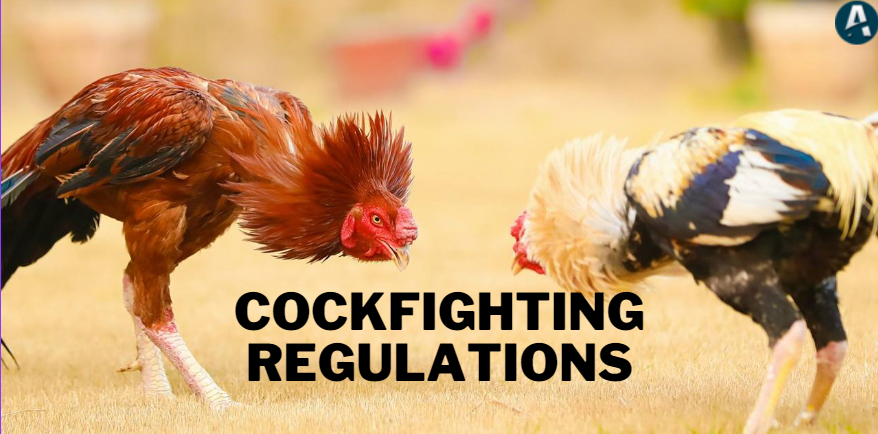
Navigating the intricate web of cockfighting regulations is crucial for enthusiasts. Discover the lesser-known aspects to ensure compliance and responsible participation in this centuries-old sport.
In this blog post, we’re diving deep into the lesser-known regulations that are pivotal in ensuring ethical and legal Cockfighting Regulations events.
Table of Contents
The Basics of Cockfighting Regulations
Cockfighting comes with its own set of rules. They’re like the unspoken guidelines of this age-old sport. These rules aim to keep things under control, protect animal welfare, and ensure everyone’s safety.
Cockfighting’s legal status can be quite the puzzle. It can be legal or illegal, depending on where you are. The commonly known rules include age restrictions and gambling limitations. But wait, there’s more to it than meets the eye!
Little-Known Local Ordinances
Let’s take a stroll through local ordinances – the hidden gems of Cockfighting Regulations. These are rules set by local governments and, trust me, they can be quirky. Some places might say, “Hey, your cockfighting arena can’t be too close to houses,” while others demand additional permits. These under-the-radar rules can seriously affect the game.
If you’re into Cockfighting Regulations, knowing these local quirks is crucial. Ignorance of these regulations can lead to unintentional violations and legal headaches.
Special Permits and Licensing
Now, let’s talk about paperwork – permits and licenses. You might think you just need one permit, but nope, it’s not that simple. These documents not only give you the green light but also spell out specific do’s and don’ts.
Getting a permit can be a journey in itself. Imagine background checks and strict adherence to animal welfare standards. It’s no walk in the park, and it varies by location.
Time and Location Restrictions
Time and location rules are often overlooked, yet they’re critical in cockfighting. They’re like the unsung heroes of regulation. These rules aim to balance the sport’s cultural importance with community concerns.
Time limits are a thing – they restrict when you can host cockfighting events. And then there are location restrictions, which decide where you can have these fights. These rules are more complex than you might think.
Cockfighting Animal Welfare Regulations

Animal welfare isn’t always in the spotlight, but it’s a big deal in Cockfighting Regulations. Lesser-known regulations focus on making sure those gamecocks are treated right.
These rules cover a range of aspects – from how you house and feed them to their medical care. The aim is to keep these birds in prime fighting condition while treating them ethically throughout their lives.
Uncommon Penalties and Consequences
Breaking these lesser-known rules? Brace yourself for consequences. Penalties can be anything from fines to time behind bars. And trust me, they’re no joke.
In some places, the fines can wipe out your bank account. And losing a permit? That’s game over for your Cockfighting Regulations endeavors. Real-life stories of folks facing these consequences really drive the point home.
Enforcement Agencies in Cockfighting Regulation
Enforcement agencies play a pivotal role in upholding and implementing cockfighting regulations. These agencies are responsible for ensuring that all rules and laws related to the sport are adhered to, thereby safeguarding public safety, animal welfare, and the integrity of the sport. Here’s a closer look at their functions and responsibilities:
- Inspection of Breeding and Training Facilities: These authorities routinely visit breeding and training sites to ensure compliance with established regulations. They assess the conditions in which gamecocks are raised and prepared for fights, verifying that standards are met.
- Monitoring the Health and Living Conditions: Their duties extend to monitoring the health and living conditions of gamecocks. This involves regular check-ups and assessments to confirm that the birds are kept in a manner that aligns with animal welfare guidelines.
- Investigation of Cruelty or Neglect: In response to reports or suspicions of cruelty or neglect towards gamecocks, local animal control authorities conduct thorough investigations. They seek to ensure that any allegations are addressed promptly and appropriately.
Challenges and Collaborations
Enforcing cockfighting regulations can be a complex task, often posing challenges to enforcement agencies. These challenges may include:
- Limited Resources: Many enforcement agencies face resource constraints, including limited budgets and personnel. This can make it challenging to conduct thorough inspections and investigations.
- Underground Operations: Some cockfighting operations operate underground, making it difficult for authorities to identify and address violations.
- Cultural Sensitivity: In regions where cockfighting has deep cultural roots, enforcement agencies must strike a balance between respecting traditions and enforcing modern regulations.
To address these challenges, many agencies collaborate with animal welfare organizations, community groups, and other stakeholders. These partnerships can help improve the enforcement of regulations while fostering better understanding and cooperation within the cockfighting community.
The Evolution of Cockfighting Laws
Cockfighting laws are like living creatures. They change over time, reflecting shifts in society’s values, ethics, and politics. So, if you want to understand the rules, you’ve got to know the history.
We’re taking you on a trip through time, from cockfighting’s glory days to the present. You’ll see how the game has gone from widely accepted to heavily regulated.
Compliance and Advocacy
Now, the practical stuff. How do you stay on the right side of the law? We’re giving you the lowdown, from permits to animal welfare standards. It’s your roadmap to responsible cockfighting.
And if you’re passionate about the sport, we’ve got something for you too – advocacy. Want to change regulations or champion ethical cockfighting? We’ve got tips on how to make a difference.
Community Engagement in Cockfighting Regulations
Community engagement is crucial in shaping perceptions and dynamics around cockfighting regulations. It involves active participation, fostering understanding, responsible practices, and positive interactions within the community.
Here’s an in-depth look at community engagement in this context:
- Awareness and Education: Community engagement begins by raising awareness and educating about cockfighting regulations. Workshops, seminars, and campaigns ensure informed participants and the public.
- Cockfighting Clubs: Community engagement includes supporting these clubs as platforms for enthusiasts to share knowledge, promote responsible practices, and collaborate with regulators for compliance.
- Ethical Practices: Involves humane treatment, responsible breeding, and adherence to regulations. A cornerstone of community engagement to maintain the sport’s integrity and minimize harm to animals.
- Collaboration with Authorities: Ensures effective regulation enforcement while respecting cockfighting’s cultural significance.
- Community Benefits: Showcasing cockfighting’s positive impact on local communities includes economic gains, tourism, and cultural preservation. Demonstrating its contribution to community well-being fosters support.
Future Trends in Cockfighting: What to Expect
Anticipating future trends in cockfighting regulations and the sport itself is essential to understanding how this practice might evolve. Several factors can influence the direction it takes:
- International Influence: The sport’s global reach means that international standards and agreements can impact regulations. Future trends may involve alignment with international guidelines on animal welfare and ethical practices.
- Alternative Forms of Entertainment: As alternative forms of entertainment gain popularity, the future of cockfighting may involve diversification of activities within the sport or a shift towards other recreational options.
- Economic Considerations: Economic factors, such as the sport’s impact on local economies, could influence future trends. Communities may adapt regulations to maximize the financial benefits of cockfighting events.
- Youth Involvement: Engaging the younger generation in the sport could shape its future. Regulations may adapt to accommodate youth participation while ensuring ethical and responsible practices.
- Public Perception: The sport’s evolution and acceptance hinge on broader community perception.
- Global Shocks: Unforeseen global events, like disease outbreaks or environmental crises, can prompt regulatory adjustments to cope with unexpected challenges.
Conclusion
Cockfighting isn’t just about roosters battling it out. It’s a world of rules and regulations that often fly under the radar. Knowing these lesser-known rules is key to responsible participation and respecting the law.
Additional Resources
We’re not leaving you hanging. Check out these links to official documents and government websites. There’s also a reading list for those who want to dive deeper into cockfighting regulations and advocacy.
Author’s Note
As the author, I want to stress the importance of responsible cockfighting. Regulations vary, but ethical treatment of animals and adherence to local laws should always be top priorities. Let’s be informed and advocate for positive change within the sport.